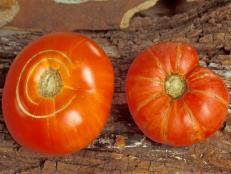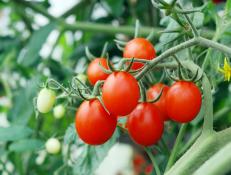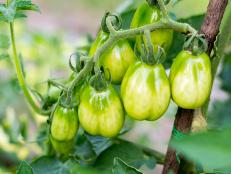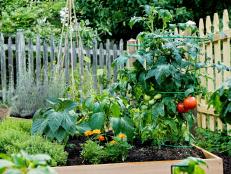Short-Season Tomato Varieties

Image courtesy of Tomato Fest
If you think your summers are too short, too cool or too cloudy to grow tomatoes, think again. That's the message from a host of tomato specialists who want to spread the word about short-season or early-fruiting tomatoes.
"I get calls from many people who had given up on growing tomatoes because they don't get enough sun or get frost too early and they are so excited to hear that it's possible with some of these new varieties," says Gary Ibsen of Carmel, California, who runs TomatoFest, a seed company specializing in heirloom tomatoes.
The problem many gardeners run into, Ibsen says, is trying to grow a standard tomato in a climate where growing conditions aren't right for the finicky plants. "People get disappointed and give up, thinking 'I just can't grow tomatoes here,' but most of the time that's not the case. Some of the newly introduced varieties originated in Siberia, and you can't get a shorter growing season than that."
Whether your preference is for hearty beefsteak slicing tomatoes or delicate multicolored heirlooms, chances are if you search a bit you can find one that will guarantee you vine-ripened, homegrown tomatoes before the season ends. Of course, every microclimate has its particular challenges. But with all the new tomato varieties that have been discovered and developed, there are a few tomato varieties that will grow just about anywhere, and many others that are particularly suited to certain regions, weather patterns and temperature ranges.
What to look for in a short-season tomato
The challenge of growing tomatoes in an area where spring comes late or summer temperatures are cool is that most tomatoes require heat to produce the sugar that makes them sweet. And then there is the problem of pollination, which of course is necessary for a tomato plant to fruit at all.
"Tomatoes require warmer temperatures to produce pollen and pollinate," says Randy Gardner, a professor at the Mountain Horticultural Crops Research and Extension Center in Fletcher, North Carolina, who specializes in hybridizing tomatoes and other vegetables.
What makes some of the newly introduced varieties so different? The plants begin producing fruit without bothering to wait for the flowers to pollinate. (This quality, called by the fancy name of "parthenocarpic," also means that these tomatoes are naturally seedless, at least early in the season.) If you live in an area with unusually cool, cloudy weather, you want to look for parthenocarpic tomatoes because you'll get fruit whether the plants pollinate or not, says Jim Myers, professor of vegetable breeding and horticulture at Oregon State University in Corvallis, Oregon. One of Myers' most popular new tomatoes is a variety called Legend. "If you start it early, you can have fruit by the third week of July, and it will set fruit even in greenhouses," he says.
Oddly enough, those who live in areas with extremely hot summers, such as the Southwest, also get good results with the fastest-fruiting varieties developed for cool climes, he says. "I've heard from some people that Oregon Spring is the only tomato that will set fruit during a summer in Arizona," Myers says. The reason? Extreme heat in June and July also interferes with pollination, so growers have to stick to varieties that fruit in 55 to 65 days. Another idea to try: Plant smaller, bushy determinate tomato varieties in containers, then move them into the shade during the middle of the day.
Many of the other short-season varieties come out of Russia and other Eastern European countries, because tomatoes there naturally evolved to accommodate late snows and early frosts, Ibsen says. These new heirloom varieties — so named because they were passed on from generation to generation — have all the prized qualities of heirlooms such as unusual colors, shapes, and flavors and yet are hardy and disease resistant as well.
Short-Season Tomato Varieties
See All PhotosThe experts' top picks
Here are a dozen of the best early-season and cool-climate tomatoes:
'Anna Russian'. Brought to Oregon by a Russian immigrant generations ago. Pinkish-red, heart-shaped fruits are very early, large and juicy; vines are hardy. Indeterminate. 65-70 days.
'Buckbee's New 50 Day'. Good yields of great tasting 4-oz. red round fruit. Both cold and heat tolerant. Indeterminate. 55 days.
'Gold Nugget'. An early golden cherry tomato; produces sweet flavorful crack-resistant fruit. Determinate. 60 days.
'Legend'. Very large, glossy red fruit; very early and hardy; resistant to late blight fungus, the bane of cool and rainy climates. Determinate. 68 days.
'Oregon Spring'. Big red fruit with good flavor. One of the earliest of all, plants are resistant to both cool and hot temperatures. Seedless (parthenocarpic) compact determinate. 58 days.
'Northern Lights' – Tender, early 3-1/2-inch, round, yellow-orange beefsteak with red highlights, intense flavor. Hot-weather tolerant; bears till frost. Indeterminate. 56 days.
'San Francisco Fog'. Produces clusters of round, smooth, red fruit with good flavor. Well adapted to cool, wet areas where grey skies may cause tomatoes not to set their fruit. Indeterminate. 70 days.
'Siletz'. Deep red slicer; one of the earliest producers and king of cooler climates; produces well in hot climates as well. Determinate. 52 days.
'Stupice'. Early and dependable, popular in the Northwest and in areas with hot summers. Firm, juicy, small to medium size fruit; three- to four-foot bush with unusual potato like foliage. Indeterminate. 60 days.
'Sunset's Red Horizon Huge'. Red, five-inch, meaty, heart-shaped fruits. One of the first varieties to produce, and frost-resistant as well. Indeterminate. 69 days.
'Tobolsk'. 100-year-old heirloom from the Ural mountains of Russia. Sweet three-inch, light yellow to orange fruit with excellent acid balance; Not as early but ripens in cool weather. Indeterminate. 80-85 days.
'Valencia Heirloom'. From Maine. Round, 10-ounce, orange fruits with rich flavor. Good choice for cooler growing areas. Indeterminate. 76 days.
Tips for speedy tomato growing in short-season areas
The most important step in making sure you don't spend your summer fruitlessly nurturing your tomato plants (pun intended) is to choose your varieties wisely. Before you head out to your local nurseries, spend some time perusing seed catalogs and scouting varieties that seem likely to do well in your area. But if you get a late start or your selection is limited, there are also plenty of things you can do to help your tomatoes get the best start possible:
- Start seeds indoors or in a greenhouse – this can give you a headstart of many weeks.
- Extend your season with cold frames, heat mats and other tools.
- In a cool climate or a cold spring, plant tomatoes on the south side of the house protected from wind.
- Mulch when planting; it raises soil temperature and helps dry out soil too.
- Protect tomato plants from heavy rains, which increase the chances of blight.
- Plant a variety of different plants, preferably some that are determinate and some indeterminate. The name determinate means what it says – determinate plants grow to a pre-determined height then stop, flower and fruit. What this means is that determinate tomatoes are the earliest to fruit, but you tend to get a bumper crop all at once and then no more. Indeterminate tomatoes keep growing right up until frost hits, setting fruit as they grow. The trailing foliage can keep the soil cool and delay ripening, so stake up branches to encourage fruit to ripen earlier. If you want to have tomatoes from mid-summer through early fall, you need to plant both types. (Some experts claim that indeterminate tomatoes taste better, but this could be argued forever; it's true, however, that most heirloom varieties are indeterminate.)
Final Thoughts
The pleasure of biting into a ripe, homegrown tomato should never be denied to any determined gardener, so if you live —and garden — in an area with unusual climate or weather challenges, be sure to consult with your local nurseries, or check out the resources offered by nearby agricultural and master gardener programs. Specialized seed companies based in areas with similar climates to yours should be able to suggest varieties to try. Above all, don't be afraid to experiment.
"Set aside part of your garden to experiment with and try out different types," says Ibsen. "If there's a kind of tomato that intrigues you, don't let the 'rules' stop you; see if you can make it work. That's one of the adventures of growing tomatoes."
















![Homegrown variety of winter squash. Homegrown winter squash. 195956_3603429601142_787136137_n[2].jpg](http://hgtvhome.sndimg.com/content/dam/images/grdn/fullset/2014/2/7/0/195956-3603429601142-787136137-n-2.jpg.rend.hgtvcom.231.174.suffix/1452646912247.jpeg)































